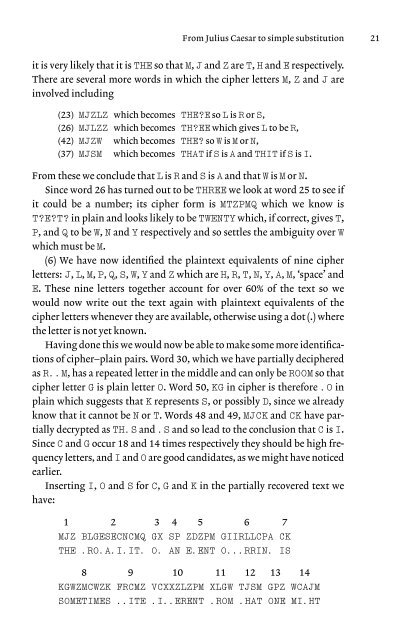Code and ciphers: Julius Caesar, the Enigma and the internet
Code and ciphers: Julius Caesar, the Enigma and the internet
Code and ciphers: Julius Caesar, the Enigma and the internet
You also want an ePaper? Increase the reach of your titles
YUMPU automatically turns print PDFs into web optimized ePapers that Google loves.
From <strong>Julius</strong> <strong>Caesar</strong> to simple substitution 21<br />
it is very likely that it is THE so that M, J <strong>and</strong> Z are T, H <strong>and</strong> E respectively.<br />
There are several more words in which <strong>the</strong> cipher letters M, Z <strong>and</strong> J are<br />
involved including<br />
(23) MJZLZ which becomes THE?E so L is R or S,<br />
(26) MJLZZ which becomes TH?EE which gives L to be R,<br />
(42) MJZW which becomes THE? so W is M or N,<br />
(37) MJSM which becomes THAT if S is A <strong>and</strong> THIT if S is I.<br />
From <strong>the</strong>se we conclude that L is R <strong>and</strong> S is A <strong>and</strong> that W is M or N.<br />
Since word 26 has turned out to be THREE we look at word 25 to see if<br />
it could be a number; its cipher form is MTZPMQ which we know is<br />
T?E?T? in plain <strong>and</strong> looks likely to be TWENTY which, if correct, gives T,<br />
P, <strong>and</strong> Q to be W, N <strong>and</strong> Y respectively <strong>and</strong> so settles <strong>the</strong> ambiguity over W<br />
which must be M.<br />
(6) We have now identified <strong>the</strong> plaintext equivalents of nine cipher<br />
letters: J, L, M, P, Q, S, W, Y <strong>and</strong> Z which are H, R, T, N, Y, A, M, ‘space’ <strong>and</strong><br />
E. These nine letters toge<strong>the</strong>r account for over 60% of <strong>the</strong> text so we<br />
would now write out <strong>the</strong> text again with plaintext equivalents of <strong>the</strong><br />
cipher letters whenever <strong>the</strong>y are available, o<strong>the</strong>rwise using a dot (.) where<br />
<strong>the</strong> letter is not yet known.<br />
Having done this we would now be able to make some more identifications<br />
of cipher–plain pairs. Word 30, which we have partially deciphered<br />
as R..M, has a repeated letter in <strong>the</strong> middle <strong>and</strong> can only be ROOM so that<br />
cipher letter G is plain letter O. Word 50, KG in cipher is <strong>the</strong>refore .O in<br />
plain which suggests that K represents S, or possibly D, since we already<br />
know that it cannot be N or T. Words 48 <strong>and</strong> 49, MJCK <strong>and</strong> CK have partially<br />
decrypted as TH.S <strong>and</strong> .S <strong>and</strong> so lead to <strong>the</strong> conclusion that C is I.<br />
Since C <strong>and</strong> G occur 18 <strong>and</strong> 14 times respectively <strong>the</strong>y should be high frequency<br />
letters, <strong>and</strong> I <strong>and</strong> O are good c<strong>and</strong>idates, as we might have noticed<br />
earlier.<br />
Inserting I, O <strong>and</strong> S for C, G <strong>and</strong> K in <strong>the</strong> partially recovered text we<br />
have:<br />
1 2 3 4 5 6 7<br />
MJZ BLGESECNCMQ GX SP ZDZPM GIIRLLCPA CK<br />
THE .RO.A.I.IT. O. AN E.ENT O...RRIN. IS<br />
8 9 10 11 12 13 14<br />
KGWZMCWZK FRCMZ VCXXZLZPM XLGW TJSM GPZ WCAJM<br />
SOMETIMES ..ITE .I..ERENT .ROM .HAT ONE MI.HT

















